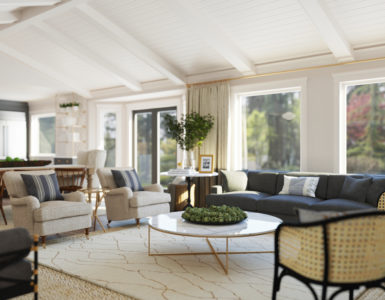America’s #1 Cleaning Expert, Don Aslett shares some of his experience and knowledge in the best ways to clean wood.
___________________________________________________
Though wood is one of the best camouflagers of soil and damage (they blend right in with the grain to become almost invisible), wood does get dirty, especially where hands are often touching it. Soils such as handprints and grease have to be washed off—you can’t just take a dustrag to them and polish them away. Washing means moisture, and the thought of using it around wood terrifies wood lovers. But most modern wood surfaces have several coats of seal on them (polyurethane, varnish, or lacquer). This gives them a tough, transparent coating that doesn’t allow moisture to ever touch the wood itself—it’s like a thin layer of glass over the wood. When you wash wood like this, you’re washing the finish, not the wood. So applying a cleaning solution and then drying the surface quickly has zero effect on the wood. It just removes the soil from the surface of the finish.
Water can cause a problem if you flood a wood surface, or leave moisture in prolonged contact with it. When you do this that moisture will finally find tiny cracks, holes, or damaged areas in the finish and soak into the wood itself, causing swelling, cracking, splitting, or other damage. Pressboards and plywoods, especially, will swell up greatly when soaked with water, and not shrink back to normal as they dry like other woods might.
So the first and most important step in wood care is to determine just what kind of finish is on the wood, or if there is any finish at all.
WOOD WITH A WELL-SEALED FINISH
Most modern home furnishings made of wood that has a slick, shiny surface (such as kitchen cabinets, dining tables and other furniture, paneling, and glistening hardwood floors) have several coats of finish on them. When they need it, they can be damp-wiped or damp-mopped with a mild, neutral cleaner like Top Sheen or Wood Wash. Just remember to always wipe and buff wood floors dry immediately afterward with a cleaning cloth, to remove the moisture and any detergent residue that may remain. This allows the nice shiny surface to continue to shine. Cleaning wood this way will also leave the surface more resistant to resoiling, whereas applying and reapplying polishes and waxes will often cause the surface of wood to get gummy and sticky, which attracts and holds dirt. Paneling with a sealed surface can be cleaned by the two-bucket system, using Top Sheen, Wood Wash, or Murphy’s Oil Soap.
If you encounter a hard-to-remove spot while cleaning sealed wood, scrub gently with a wetted white nylon scrub sponge.
When you need to polish
As noted earlier most wood with a well-sealed finish benefits more from cleaning (see above) than polish. Using furniture polish can help wood with a finish that is starting to look worn. Varnished and lacquered finishes can get dulled and worn from use, and a furniture polish will fill tiny scratches in the surface to help it look better for a while. If you use a polish, stick to the same type to avoid streaking. Professionals use a carnauba-based product called Wood to Wood when polish is needed, instead of oils that will only build up and encourage fingerprints. Carnauba is the original wood wax and polish. It adds beauty and luster to wood, and leaves behind a microscopic coating that resists dust.
OILED WOOD
The wood in some furniture and paneling and other home surfaces may appear dull and more “natural” looking. Chances are that finishes like these (including some floors) have been treated with tung oil or other penetrating oils, whose purpose is to soak into the wood and condition it, keep it from drying out and cracking and splitting. Most oil-treated finishes, even though they don’t shine, will hold out moisture fairly well. So you can wash finishes like this, too, to clean them. Just do it more conservatively. This means, for instance, dipping your cleaning cloth into the solution and wringing it almost dry, and then going over the surface with it a couple of times to loosen and remove the soil. Then immediately follow this damp wiping with a dry towel to remove all moisture and detergent residue.
Oiled wood does need to be reoiled about once a year, to keep it stain and moisture resistant. Apply the oil, rub it in, leave it on a while, then blot up the excess. Don’t use furniture polish on oiled wood.
UNFINISHED WOOD
Unvarnished or unfinished woods around the house (such as used in some kinds of “rustic” decor, for example) are handsome, and carefree in the sense that flyspecks, nicks, and overall aging often just enhance their rustic look. However grease and many other stains will sink into the porous surface and be hard if not impossible to remove. If unfinished wood gets stained or soiled, try first to clean it with a soft rubber “dry sponge” from a janitorial-supply store. If that doesn’t work, try a cloth lightly dampened in all-purpose cleaner (don’t use too much water, or you’ll just spread the soil or cause it to sink further into the surface). Individual not-too-deep stains can be sanded off carefully with fine sandpaper. If you find yourself trying to clean unfinished wood frequently, you should break down and clean it well and then seal the surface with a low-gloss urethane. Or limit the use of such finishes to places that get little human contact.
WOOD USED IN EATING OR FOOD PREPARATION UTENSILS
Whether it has an oiled finish or been coated with a more permanent sealer, it should only be damp-washed or immersed in dishwater quickly and then removed and dried immediately. Never soak wooden bowls and the like in water. Treat wooden utensils and surfaces of this type at least yearly with mineral oil (not just any oil). Oil the whole surface generously, let it soak in overnight, then wipe off the excess.
TO KEEP WOOD LOOKING GOOD
• Clean up spills and water leaks immediately, the minute they happen.
• Mat all approaches to wood flooring.
• Sweep, vacuum, or dust often, to keep damaging dirt and grit off wood surfaces, and damp-mop or wipe them when needed.
• Head off damaging footwear and toys, and people with sharp, heavy things that are bound to be set down on or dropped onto your nice wood table or floor.
• Always clean wood well before deciding it needs to be refinished. And refinish wood with a protective finish when the finish is badly worn.















Add comment